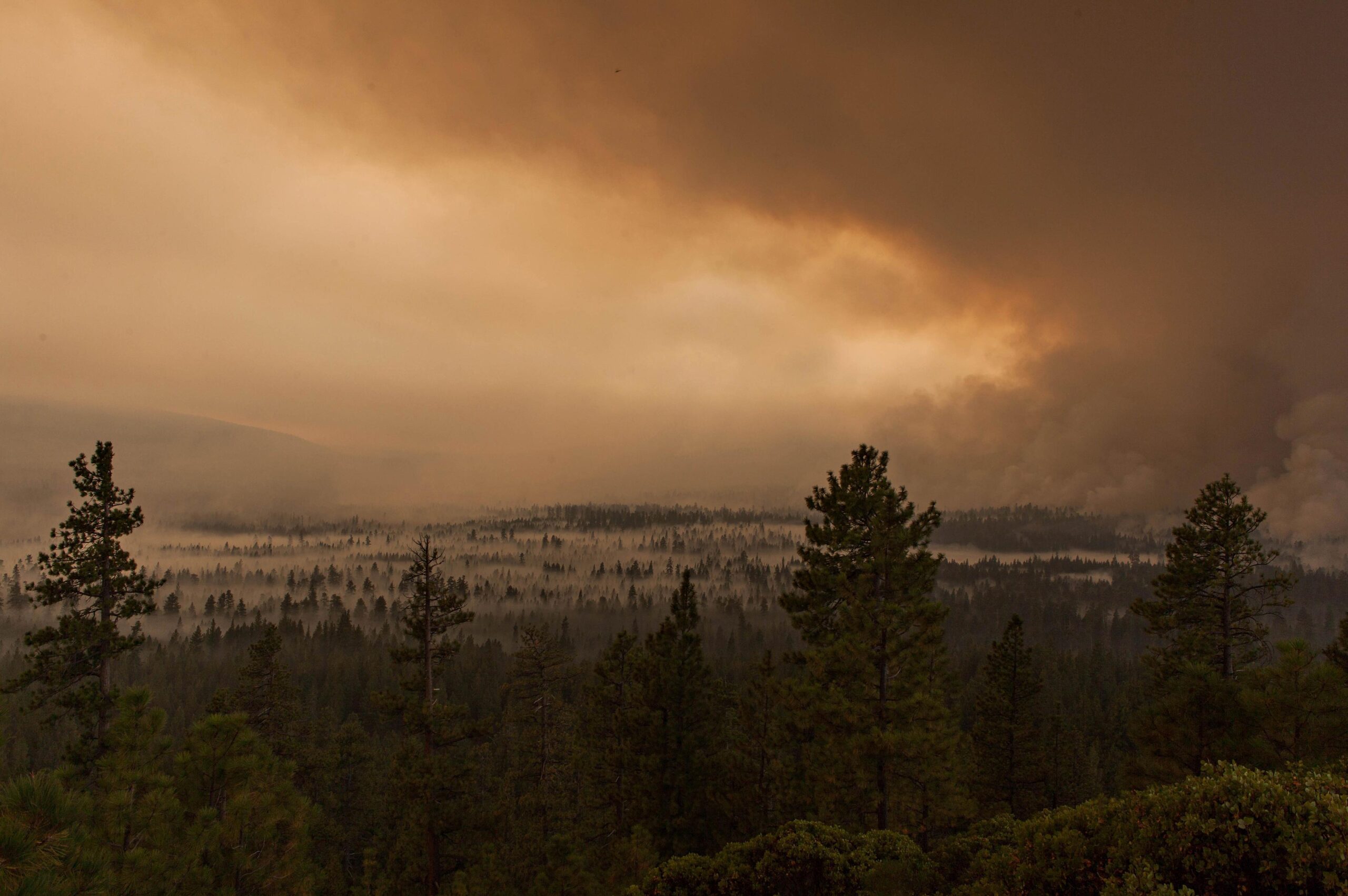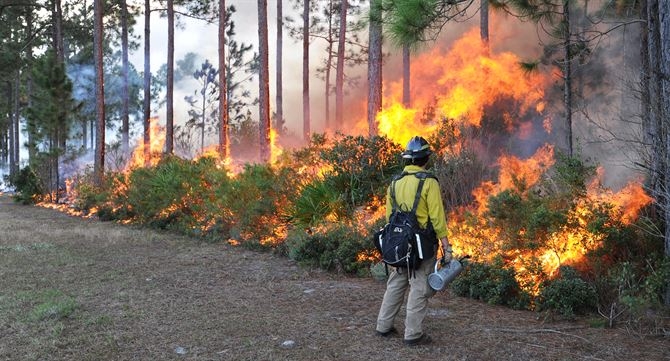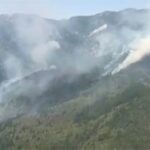Will this season’s devastating wildfires lead to more forest management collaboratives between the public and private sectors?
In August this year, a wildfire near the central Oregon town of Sisters threatened more than 2,000 residences. The Milli fire, as it is known, grew to 24,000 acres in the Deschutes National Forest and Three Sisters Wilderness.
The Milli fire is one of more than a dozen large wildfires that took hold in the state this summer, in what has been a bad season for forest fires across the entire west of the country.
But unlike many of this season’s wildfires that grew out of control – the Eagle Creek fire in the Gorge received the most attention because of its proximity to Portland – the Milli fire is cited as a success story because it was easily contained. Most of the fire is now under control.
The Deschutes Collaborative Forest Project, a group of stakeholders from the private and public sectors, claim the tree thinning, mowing of brush and controlled burns the collaborative did earlier this year helped reduce the intensity and duration of a portion of the fire, making it easier to put out.
RELATED STORY: WILDFIRE APOCALYPSE: CLIMATE CHANGE VS. FOREST MANAGEMENT
The Milli fire is an example of the positive outcome of how forest management collaboratives can help reduce wildfire risk while maintaining a healthy forest. As forest fires are predicted to grow in intensity and duration, partly because of changes in the climate, consensus is growing that more of these collaboratives are needed between the private and public sectors to cut down fire risk.
Twenty-five forest management collaboratives exist in Oregon in which timber companies, environmental groups and governmental agencies work together to thin forests and do controlled burns.
But the collaboratives cover only a relatively small portion of public land. Millions of acres of forests are at risk of going up in smoke because of a lack of forest management.
“There is a real need for restoration management on public forestland,” said Mark Stern, director of forest conservation at the Nature Conservancy. The nonprofit has identified eight million acres of dry forest in southwest and eastern Oregon that need restoration to prevent wildfire risk.
RELATED STORY: TIMBER TOWN: A FOREST COLLABORATION SAVES ROUGH & READY TIMBER COMPANY
A big obstacle is a lack of money. The U.S. Forest Service is running out of funds to pay for environmental reviews and forest management activities, such as tree thinning, on federal forestland.
The lack of resources comes down to the fact the agency is spending more of its budget on fighting fires rather than preventing them. Ten years ago, the Forest Service spent 16% of its annual budget on fighting fires. For the first time this year, it spent more than 50%. In Oregon alone, the agency has doled out $300 million to fight this season’s fires.
“In the Pacific Northwest, there is one million acres of land that has gone through the review process, but there is not enough money for management,” said Dylan Kruse, director of government relations at Sustainable Northwest.
“We need a fire funding fix. We have to fund fighting wildfires like the emergencies they are,” he said.
A piece of legislation sponsored by Sen. Ron Wyden aimed at reforming the way wildfires are funded – the Wildfire Disaster Funding Act – could gain more traction in Congress in the aftermath of this year’s devastating wildfires.
The bill would fund the costs of fighting wildfires from a natural disaster fund, leaving more money available for managing forests to prevent wildfires.
While efforts are underway to apportion more federal money for restoring forests, the private sector could also play more of a role in investing in forest management collaboratives.
“They (the private sector) are very important participants in collaboration. They invest in infrastructure and workforce. They can invest additional dollars in forest management,” said Kruse.
RELATED STORY: BEAM ME UP: A TALL TIMBER ALLIANCE POSITIONS OREGON AS A FRONT RUNNER IN GLAMOROUS NEW WORLD OF WOODEN SKYSCRAPERS
The collaborative structure has worked well for Bruce Daucsavage, president of Ochoco Lumber. In 2012, the company’s lumber mill in John Day, Oregon, was in danger of closing because of a lack of log supply from the adjacent Malheur National Forest in southwest Oregon. The company relies mostly on lumber from national forests.
Ochoco Lumber was able to keep its mill open after it became involved in the Blue Mountain Forest Partners, a coalition of logging companies, environmentalists, landowners and government officials, which collaborate on forest management strategies for the Malheur National Forest. The collaborative helped secure a supply of logs to keep Ochoco’s mill operating.
Daucsavage calls collaboratives a “winning solution” because the forest management helps reduce wildfire potential as well as produce products for mills that generate profits.
But he added the collaborative model may not be to all mill owners’ tastes. Daucsavage says he has been accused of giving up his independence. “Our mill has become a community mill. It is really unique. Most private companies don’t want anything to do with this,” he said.
Getting involved in public-private partnerships would mean a big cultural shift for many timber companies.
“There are opportunities, but you have to find the right partners. We are stubborn beasts. It takes the ability to say we don’t have all the answers. You have to get out of your comfort zone,” said Daucsavage.
 Milli fire burns near Sisters
Milli fire burns near Sisters
Travis Joseph, president of the American Forest Resource Council, an association of forest products companies, supports increased forest management collaboratives where they are successful. But they do not work everywhere, he adds. This is the case on the western side of the state where forest fires are less common and where there is no consensus on why there should be thinning and harvesting.
Joseph says there is a “huge business opportunity” for the Forest Service to sell dead and dying trees damaged by wildfires to the mills. These trees still have economic value if they are shipped to mills within six months of being burnt, he said.
But this rarely happens because it can take the federal government years to do an environmental review of fire-damaged lands. By this time, the wood is no longer valuable, said Joseph.
“My members are starved of wood products. Meanwhile, millions of trees are burning up,” he said. “The Forest Service and Bureau of Land Management have the tools to expedite harvest. But the agencies are slow to move on projects quickly.”
The U.S. Forest Service did not respond to a request for comment.
This year’s wildfires have raised a lot of attention on the forest fire issue in Oregon. The ash from nearby wildfires that fell on Portlanders a couple of weeks ago arguably did more to raise public attention to the risk of wildfires than ever before.
The public perception of how the private sector manages public forests will be critical to acceptance for increased collaborative forest management.
Bob Williams, president of Pine Creek Forestry, a New Jersey forestry services firm, advocates for what he calls a future of “ecological forestry”, which he said “provides an avenue” for the public to accept private-sector involvement in public forests.
“How nice it would be for people to see industry as the keepers of the forest,” said Williams.





